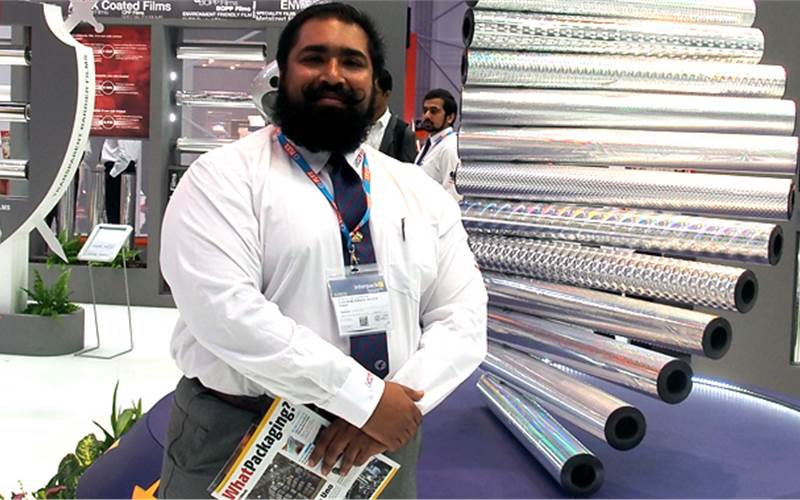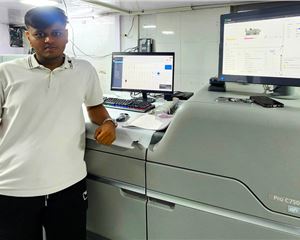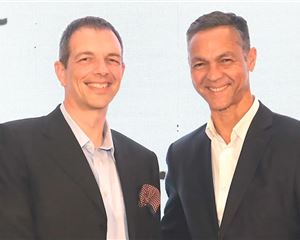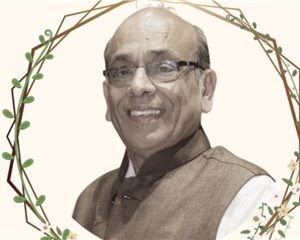Anantshree Chaturvedi: “We can supply films to any part of the world within two weeks”
In 30 years of operations, Uflex has grown from a small-scale business to become a global film manufacturer with a footprint unlike anyone else. The gen-next at Uflex, Anantshree Chaturvedi, vice chairman and CEO of Flex Films International, brings an extensive cross-border experience in manufacturing, retail, and information technology and a global perspective. This reflects in Uflex’s efforts towards creating unique products and its robust strategy for the future. Anantshree Chaturvedi in conv
22 May 2017 | By Rushikesh Aravkar
Rushikesh Aravkar (RA): Tell us about your role and your goals in the company...
Anantshree Chaturvedi (AC): I'm the vice chairman and CEO of Flex Films International (the global film manufacturing arm of Uflex). The best way to define my role in the company is that I'm the cultural ambassador of Uflex. I'm working very hard that this company, which was started by my father 30 years ago now emerges in a global way and we create the systems and protocols that that form the bedrock of Uflex’s culture. My goal is to ensure survival and profitability of Uflex.
RA: What are the trends that you are trying to present at Interpack?
AC: We are showcasing our high barrier nylon replacement films. Nylon as a substrate has had a very high price volatility in the past two years. It is going through a cyclical shift in the marketplace where nylon barriers were used just for the sake of being used. What we are doing is presenting alternates to that and showing people that you should buy and use the optimum barrier you want so that you don’t over-engineer or under-engineer a packaging product just for the sake of a specification. Some of our barrier films provide that opportunity.
Another thing that I’m seeing a big trend towards is our EDP film, the HP digital print film. Digital as a concept has been moving fast but I haven’t seen it pick up as yet, especially in the Asian countries. I think it’s because the print quality demand is quite high and you typically get larger run orders. There has been an interest in the Western world and the developed economies. But now I see a shift in the trend, the countries that are supplying products in close proximity to large western markets are shifting towards digital printing. The biggest of them are Mexico, Peru, and Turkey in Europe. These are the countries where I’m seeing a shift towards digital and I feel it will hit economies of scale very soon where digital will have a significant share as against rotogravure and flexo printing.

Uflex stall at Interpack 2017
RA: What kind of product segments are you referring to?
AC: The companies producing high-end organic food or organic consumables which are typically startups or starting with very niche markets are the ones which seek digital printing. They need short-run packaging to test and verify the markets. I have seen the biggest push for digital printing from the organic pet food segment. That is because it’s a high-margin, high-value item. The end users care a lot about the health of their pets. Ironically, baby food follows suit. The prime targets of digital printing are the companies which are looking to foray into the consumer space but don’t yet have an identified target market, and obviously doesn’t want to go straight into retail. These companies will opt for digital printing for short-run packaging in order to test the waters via online stores or direct to consumer space. For example, the niche healthcare companies that produce protein bars or whey protein or anything from green juice to green powder.
RA: What are the problems that the film producers across the world are facing today?
AC: There is a huge oversupply in the market. Each film manufacturer is trying to carve out a certain niche. Everybody wants to become a speciality film producer nowadays and everybody will tell you that they have a high barrier film. But there’s is no market leader other than Toray that specialises in true high barrier technology. Going forward, everybody will figure out their niche and you will see a lot more segregation when it comes to product lines and films. Having said that, there will still be players making 12 microns corona and chemical-coated films but I think the focus on these products will suffer in medium to long run just because the way the market situation is today.
RA: Do you see consolidation in the space?
AC: There is hope for consolidation in the space for sure but I cannot say for sure if consolidation will happen. I will tell you why. A lot of new players in this market have other businesses that are cash rich that can support the film business. Right now the film market is the combination of old players who are expanding and new players who have entered in when the gold rush of 2010 attracted them. People are in pretty decent financial shape. I believe the market is headed for consolidation. But how is it going to happen and who will go first and whether it will be a realistic consolidation or companies will defer their shares to private equity, that I am not sure. However, at the same time, companies are still expanding. Of course, there is varied interest in the marketplace.
RA: Uflex has also been expanding by setting up plants in the USA and Mexico. How do you find the balance between making investments and gaining the return on investments?
AC: Anyone who is making a decision to juggle that is in a difficult spot. We make the investment where it is viable and where I see the market has a need for this investment. Of course, Uflex has expanded a lot in the recent past and I would say our investments are doing well other than the USA and Mexico which are still trying to find its bearings. But as Albert Einstein has said, in the midst of difficulty you find opportunity. And I think this is the struggle for all veteran film makers who are trying to figure out what their niche is going to be.

Chaturvedi of Flex Films International at the stall
RA: What are the factors that set Uflex apart from the competition?AC: The biggest factor is that we are a global local film supplier. That means we have a footprint unlike anyone else. We are today running a model where we can supply films to any part of the world in about two weeks from one of my locations. I have a seven day turnaround delivery time. We are market leaders in service and our dedication towards the customer. Uflex deploys the customer-first approach.
RA: Please elaborate.
AC: Most of the innovations that you see at our Interpack stall were the customer requirements that we worked on one-on-one. One of the key roles of my job is to ensure that this happens more and more effectively.
RA: What is the difference between the Indian market and the western markets?
AC: The biggest two differences are the standard of quality, fit and finish for end-products is much higher in the European and US market than the Indian market. Having said that, the Indian market is much more innovative because the western markets have a lot of old legacy systems and machinery, which prevents them from innovating as fast. The Asian markets are movinf fasat with their machinery and their market concepts and ideas.
RA: A lot of food start-ups are emerging in India which understand the importance of packaging and are willing to invest in packaging their product suitably. In that sense, what’s the potential for flexible packaging?
AC: There’s huge potential. Flexible packaging, on rupee-to-rupee basis, is the most viable packaging solution. Glass is much more expensive, paper is also expensive and harder to deal with and does not provide the barrier properties. So, flexible packaging is the ideal solution. However, in the start-up scenario, there’s a careful balance that needs to be played between their customers demand for sustainability packaging as opposed to opting for simple PET-poly pouch or PP-poly pouch. Having said that I believe a consumer in a niche start-up space needs to be educated significantly.
RA: When we talk about sustainable packaging there are two approaches: recyclable packaging and biodegradable packaging. The former approach needs building of infrastructure to recycle while the late is still in R&D stage. What’s Uflex’s approach to sustainability?
AC: Uflex goes by the 3R policy: Reduce, reuse, recycle. And also re-consume. But to be honest with you there isn’t a clear answer yet. We have done a lot of work in making plant-based polymer films. Our PCR (post-consumer recycle) film is in great demand and the product is doing very well. We are producing significant chunks of volumes of PCR film and I see a lot of market interest in that segment. Uflex is definitely focused on that. However, it’s something that the market always talks about but the realistic demand for these products has only started in the last 12 months or so.
RA: There’s lot of development on biodegradable films. The issue is that even though these films will be biodegraded ultimately, in the process they will form intermediate compounds which are not necessarily safe for the environment. Do you think biodegradable films will save the planet?
AC: I am very concerned about that aspect. Without revealing much, I would say that there are certain things that we are working on internally to provide a direct solution. It is something that keeps me up at night. Also, I have seen that the market does not want oxy-biodegradable film and I don’t see the market really going effectively into that because consumers are aware that it’s not the long-term solution.
RA: Finally, what are Uflex’s plans for the future?
AC: Right now we are in the middle of consolidating our assets. We are going to look towards the next phase of expansion. Most likely there will be a line in Poland and a line in the US and of course we are also looking at other countries. We are also looking very aggressively at M&A opportunities and are hoping that consolidation bubble bursts.
Anantshree Chaturvedi

Your background
I have worked in lots of countries and lots of companies before joining Uflex. I ran my own start-up venture capitalist firm. I was with Accenture for a long time before this.
Your strategy
Uflex has grown to the size it is right now by making very quick, fast and short-term paying decisions and that has been a very effective strategy. But now for the future, Uflex is transitioning into creating long-term sustainable strategy for growth and a clarity of vision that takes the company to heights of achievement. Here I am not necessarily talking about profit and revenue and those numbers. Of course those numbers are great for the investors. But I’m talking about creating unique products that will enable Uflex to stand proudly as an Indian company and create blockbuster products. So that’s the next phase. It’s too soon to say but that’s what I hope I bring to Uflex.
Your interests
My father is a huge fan of cricket but I don’t watch sports. I love watching cinema. It is one of my side interests. A couple of years ago while I was running the VC firm, a couple of people approached me saying they wanted to make a movie and I told them that I know nothing about making a movie. So, we did a deal that I will produce their movie if they teach me how to go about the process. So, we made a seven minute short-film Emit, which won about 15 different short-film festivals. It was a lot of fun doing it and it gave me a lot of insights into the film-making business. I don’t know whether Flex Films will ever have a film studio but there’s a couple of short-films that I am making right now as well. I am trying to figure out how I can spend some time on the side to get my first feature film off the ground.












 See All
See All